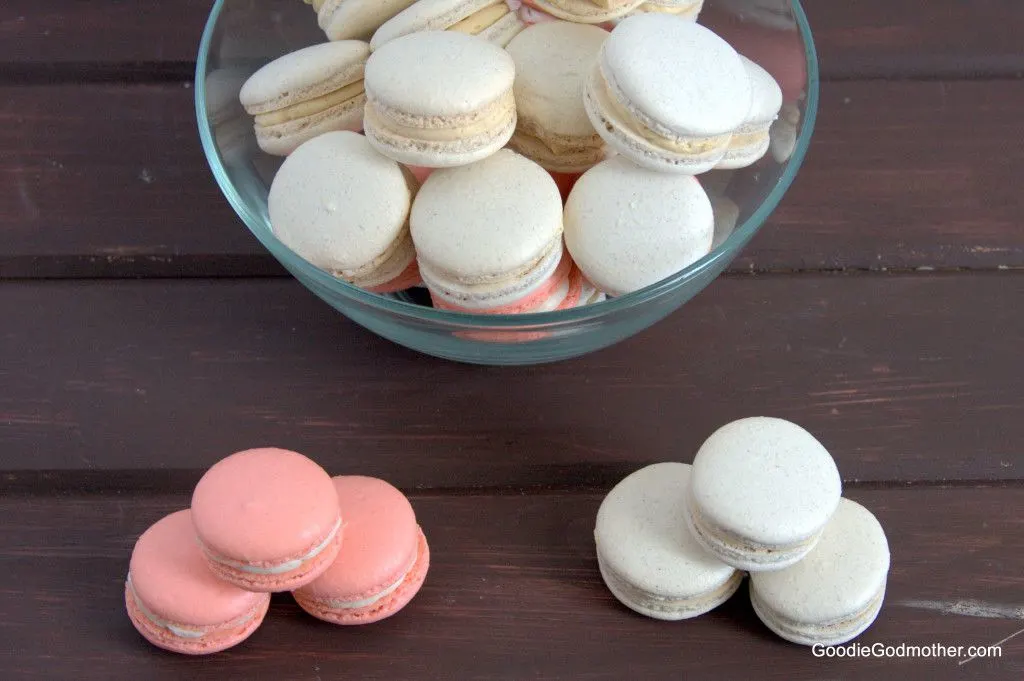
Welcome to Macarons 101! I’m the Godmother and I will be your instructor today as we take a whirlwind look at how to make macarons in the two most prevalent styles. For this post I made a speculoos macaron and a candied jalapeno pepper berry jam macaron, one using the French method, and the other using the Italian method. Class, can you tell which technique was used for which macaron? Keep reading to find out. 😉
Let’s start with a quick overview of the macaron. The macaron cookie is similar to a meringue, but not quite, and famous for its crisp/chewy texture and the infinite variety of fillings available. If you can dream it, it can likely be made into a macaron. A properly made macaron will have “feet” at the bottom of each cookie (that slightly ruffled area that looks like a sponge), smooth and even tops, and will not be hollow. All these issues can and will happen to you as they happen to everyone (go look at a professional bakery case, they’re not all perfect), but you can take steps to prevent problems, which we will discuss in the troubleshooting section.
Equipment
Thankfully, you don’t need a ton of fancy equipment to make macarons. If you’re making the French style macarons, you only need a stand mixer (this is my smaller Kitchenaid that I love so much), baking sheets, a kitchen scale, and parchment paper or silicone baking mats (like this one from Silpat or this one from Fox Run – I personally own both brands and use them interchangeably).
The kitchen scale is a MUST. Please please please don’t try to use volume measurements or you’ll just risk frustration and failed macarons. Here’s the thing about volume measurements, they’re not consistent. If you have multiple sets of dry measuring cups, weigh a cup of flour measured out with each set and I bet the weights will be different. And there’s a difference in volume between a measuring cup here in the States and one abroad. There’s also the question of how you fill the measuring cup, did you pack in the ingredients? Sift beforehand? How did you level? That’s just a lot of variation to introduce to a cookie that requires a correct ratio of fats to proteins to work. Weigh your ingredients. If you don’t have a kitchen scale, invest in a digital one. I have this one, it’s only $15, and I’ve used it for years.
Because of the cooked sugar syrup in the Italian style, you also need a candy thermometer. I started with a basic model, but after a friend had her glass tube burst and leak mercury into a batch of candy she had to throw out, I switched to digital. I have this basic model and it was one of the best investments I made, all $20. :-p I use it constantly and have done so for a few years now.
If you want a macaron mat, fine, but they’re really not necessary although they are becoming increasingly common to find. The one in the Amazon link is $6, so they’re definitely not pricey anymore. The primary reason for the mats is to help you pipe even sized cookies to make pairing easier. Personally, I count when I pipe and it works for me, but you can also easily create a reusable template that works with your silicon baking mat or parchment paper. Just draw even size circles in your desired size using a compass on a white sheet of paper, trace over the circles with a dark marker, and slide your template under your baking sheet or parchment paper, pipe, and slide it right back out. Easy!

Ingredients
The basic macaron ingredient list is not very long. You’ll need egg whites (from actual eggs, not the pasteurized kind you can purchase in a carton), finely ground almond meal, powdered (confectioner’s) sugar, and fine granulated sugar. You may also need cream of tartar and a vegetable oil, but we’ll get to that in a minute.
Thankfully, there are many kinds of almond meal readily available at your local market. I most frequently used the Bob’s Red Mill blanched almond meal, but it’s actually not ideal for making macarons because it’s a little course. At first, I would just sift my almond meal and powdered sugar together to remove any particularly large chunks, but then I changed my method. I make my own “macaron flour mix” by mixing equal parts almond meal and powdered sugar by weight in my food processor and pulsing 4-5 times until I end up with a very nice fine meal. I would usually do this two pounds at a time so I had flour on hand for multiple batches, all using the Italian method. For the French method, the ratio of sugar to almond meal is different, so I would mix per batch to ensure consistency.
If you get really motivated and have blanched almonds, feel free to make your own! I have, it’s a bit of a process, and you have to be careful to stop before you reach “almond paste”. To do this, pulse the almonds in your food processor until they’re coarsely ground, and then I like to add in my confectioners sugar to finish the process and coat the almond bits so they don’t stick to each other and finish pulsing to a fine meal before sifting and going on my merry way. But it’s much easier to just buy it, trust me.
My preferred fillings are Swiss meringue buttercream or ganache based with a few exceptions. For the speculoos macarons, I used leftover French meringue buttercream from my Valentine’s Day speculoos mervielleux and it was delicious and quite rich. The recipe for that filling can be found in the mervielleux post. I made a Swiss meringue buttercream with chopped candied jalapenos and pepper berry jam for the other macarons pictured. Recipe for that filling below.
If you are making a ganache filling, the general ratios for the various chocolates are: semisweet chocolate, 1 part chocolate to 1 part cream; milk chocolate, 2 parts chocolate to 1 part cream; white chocolate, 3 parts chocolate to 1 part cream. Use a couverture chocolate when possible instead of something like chocolate chips because it’s uncoated and will give you a lovely smooth ganache. Since the flavor of the filling is so very important in a macaron, use good quality ingredients!
What’s the difference between the French and Italian styles anyway?
The main difference is that the Italian style uses a sugar syrup, cooked to soft ball stage in the batter. This creates a slightly sturdier shell that, in my experience, withstands variations in climate and temperamental ovens a bit better to create a consistent product when made in large batches.
The French style doesn’t have this sugar syrup and results in a slightly more delicate and lighter shell. If you try the two side by side, you may notice a small difference in texture, but most people consider them interchangeable. I would experiment with both and see which you like best.
Now, let’s delve into the different styles. If you’re just here for troubleshooting and frequently asked questions, skip to the bottom of the post.
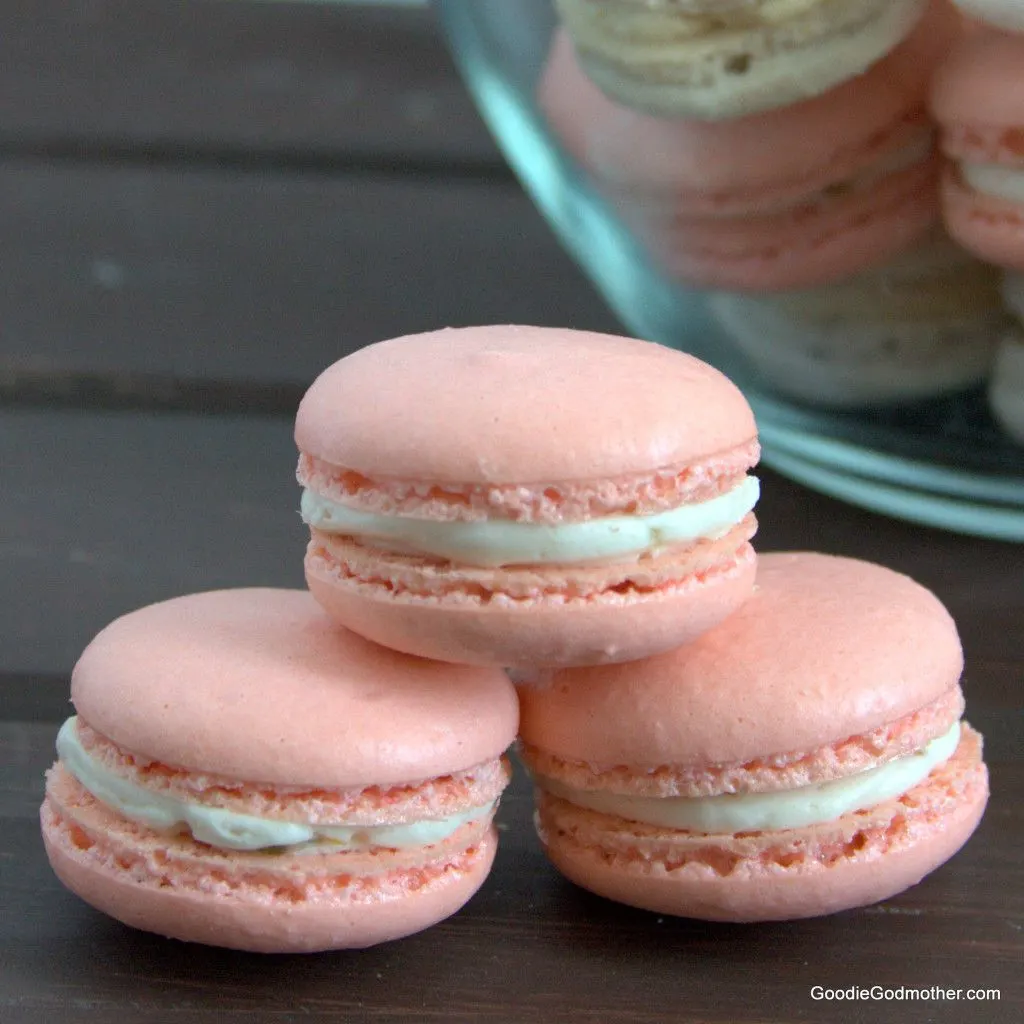
A Step by Step Guide To Macarons: The French Method
- Measure all your ingredients by weight. Be sure to sift together the powdered sugar and almond meal or pulse in a food processor so they are very fine. Place in a bowl and set aside.
- Place your egg whites and a pinch of salt in the bowl of your stand mixer fitted with the whisk attachment. Start whisking at medium speed until the egg whites look like a bubble bath and then add your caster sugar, 1 tbsp at a time.
- Once all the sugar has been incorporated, increase the mixer speed to high and whip until the egg whites have nearly reached a stiff peak. You don’t want to over beat or you’ll have too much air in the egg whites and the shells won’t rise properly. You’ll know it’s ready when the egg whites are stiff enough to form a soft “cloud” inside the whisk.
- Now it’s time for the most important step, the macaronage, or combining of the almond flour/sugar mixture into the egg whites. If you’re adding color, add your gel or powder color here. Please read the FAQ section for a few very important notes about coloring your macarons.
- Form a small well in the egg whites and dump in the entire almond meal/sugar mixture. Using a rubber spatula, cut into the center of the bowl, scoop out to the edge of the bowl, and fold in. Work your way around the bowl to make sure the ingredients are well incorporated. Keep going until you have a nice homogeneous mixture that moves at the pace of slow lava when you scoop up a bit and drop it back in. This takes about 40-50 strokes. If you under-mix, you risk ending up with funny lumps of unmixed dry ingredients and hollow shells. If you over-mix, you’ve beaten too much air out of your macarons and they will spread too far and won’t rise to give you those darling little feet everyone loves so much.
- Carefully fill a piping bag with your macaron mixture and pipe onto your prepared baking sheets in little rounds. I have a reusable 16″ Ateco pastry bag I use exclusively for macarons and I fit it with a #12 Wilton round tip. If you are using a piping guide, place it underneath your silicon mat or parchment paper in such a way that you can easily pull it out without disturbing your piped macarons and follow your guide. If you are free-handing as I do, I place my piping tip just over the surface of my sheet, pipe using medium pressure, count to two, stop the pressure, and using a slight swirling motion, lift my piping bag away from my macaron. The swirling motion helps prevent tiny little points from forming on my shells. If you do end up with tiny point, wet your finger and gently pat them down.
- Fill both your baking sheets and then take each sheet firmly in your hands and rap them twice on the counter. Rotate 90 degrees and rap them twice more. This is to remove any air bubbles that would cause your shells to crack in your oven.
- Allow the shells to rest, uncovered, while you preheat your oven to 300 F (see my notes about this in the FAQ section). The macarons are ready to go into the oven when the tops have dried slightly and you can touch the surface lightly without any macaron batter sticking to your finger.
- Bake the shells one sheet at a time for 15-18 minutes, until you can easily lift a shell cleanly off the baking sheet. There should be no browning on the shells. They’ll still taste good, but if they’ve browned, they’re over baked.
- Remove the shells from the oven and allow them to cool on the baking sheet 5 minutes before transferring, upside down, to a cooling rack to cool completely.
- Pair your shells together and fill with your desired filling. Today I used a candied jalapeno pepper berry Swiss butter cream.
- Allow to rest 24 hours in the refrigerator before eating so the filling has a chance to meld with the shells. Macarons may be refrigerated in an airtight container up to 10 days, or frozen (very well wrapped) for longer storage. Remove from the refrigerator 15-30 minutes before eating to allow the filling to soften, or just eat cold.
- Enjoy!
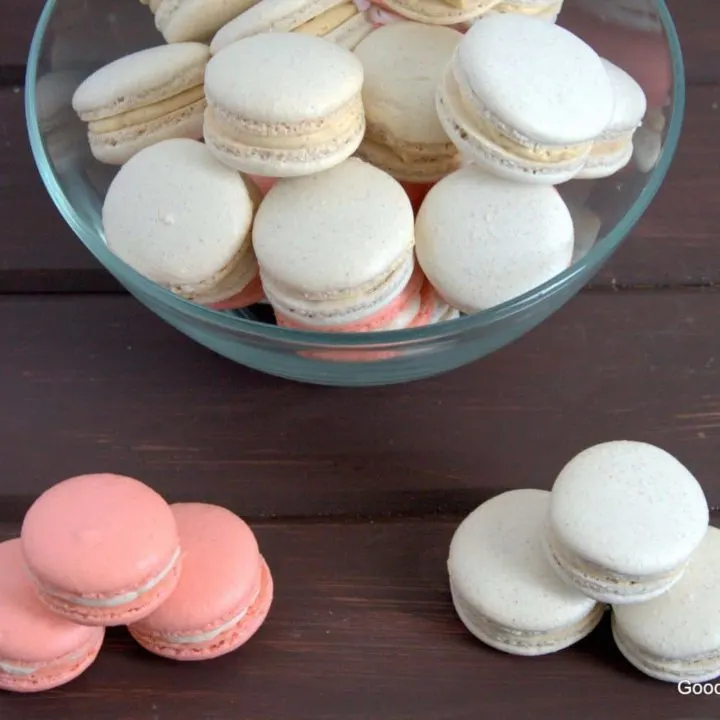
Jalapeno Pepper Berry Swiss Butter Cream
Ingredients
- 2 egg whites
- 1/2 cup sugar
- 12 tbsp unsalted butter, softened
- 2 tbsp chopped candied jalapenos
- 1/4 cup pepper berry jam
Instructions
- Place the egg whites and sugar in the bowl of your stand mixer and set that over a pot of simmering water, making sure the bowl is not touching the water. Stir constantly until the sugar has dissolved.
- Place the bowl on your stand mixer and whisk at high speed until the egg whites are no longer hot and soft peaks form. Add the softened butter 1 tbsp at a time.
- Continue whipping until a smooth buttercream is formed.
- Add your candied jalapenos and jam and whisk at medium speed to combine for 2 minutes.
A Step by Step Guide to Macarons: The Italian Method
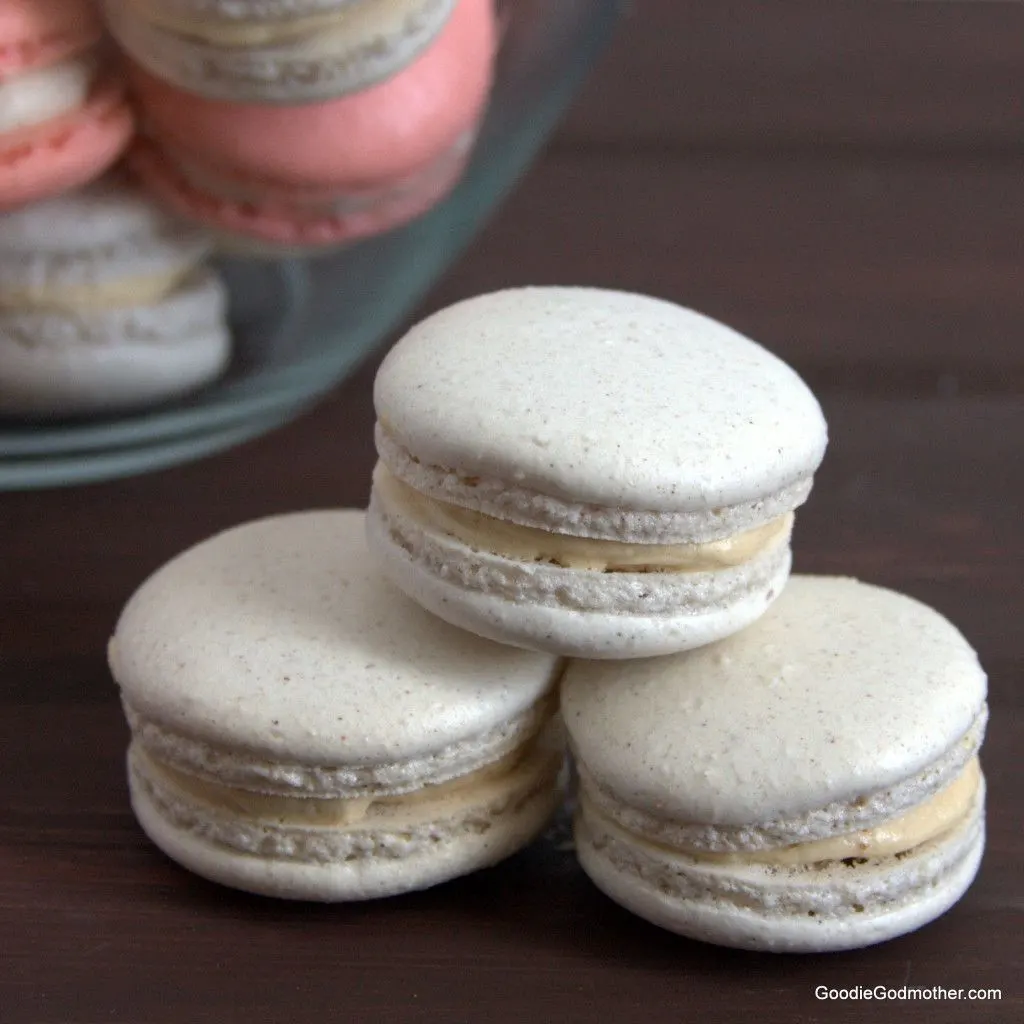
- Measure all your ingredients by weight. Be sure to sift together the powdered sugar and almond meal or pulse in a food processor so they are very fine. Place almond meal/sugar mixture and 55 g egg whites in a bowl and set aside (do not mix together).
- Place 150 g caster sugar (fine granulated sugar) in a small saucepan with 25 g filtered water and fitted with your thermometer. Place the other 55 g egg whites in the bowl of your stand mixer, fitted with the whisk attachment.
- Cook the sugar and water over medium heat, swirling the pan occasionally to ensure even heating until the mixture reaches the soft ball stage at 235 F. When the mixture reaches 220 F, start your stand mixer at medium speed to start to foam the egg whites.
- When the sugar syrup reaches soft ball stage, immediately remove from the heat, increase your mixer speed to high, and slowly pour in the sugar syrup in a thin stream avoiding the sides of the bowl as much as possible.
- Continue whipping the egg whites until you’ve reached a soft/firm peak. You don’t want to over beat or you’ll have too much air in the egg whites and the shells won’t rise properly. You’ll know it’s ready when the egg whites are stiff enough to form a soft “cloud” inside the whisk.
- Now it’s time for the most important step, the macaronage, or combining of the almond flour/sugar/other half of the egg whites mixture into the egg white/sugar syrup mixture. If you’re adding color, add your gel or powder color here. Please read the FAQ section for a few very important notes about coloring your macarons.
- Form a small well in the egg whites and dump in the entire almond meal/sugar/egg white concoction. Using a rubber spatula, cut into the center of the bowl, scoop out to the edge of the bowl, and fold in. Work your way around the bowl to make sure the ingredients are well incorporated. Keep going until you have a nice homogeneous mixture that moves at the pace of slow lava when you scoop up a bit and drop it back in. This takes about 40-50 strokes. If you under-mix, you risk ending up with funny lumps of unmixed dry ingredients and hollow shells. If you over-mix, you’ve beaten too much air out of your macarons and they will spread too far and won’t rise to give you those darling little feet everyone loves so much.
- Carefully fill a piping bag with your macaron mixture and pipe onto your prepared baking sheets in little rounds. I have a reusable 16″ Ateco pastry bag I use exclusively for macarons and I fit it with a #12 Wilton round tip. If you are using a piping guide, place it underneath your silicon mat or parchment paper in such a way that you can easily pull it out without disturbing your piped macarons and follow your guide. If you are free-handing as I do, I place my piping tip just over the surface of my sheet, pipe using medium pressure, count to two, stop the pressure, and using a slight swirling motion, lift my piping bag away from my macaron. The swirling motion helps prevent tiny little points from forming on my shells. If you have tiny points form, wet your finger and gently press down to smooth.
- Fill both your baking sheets and then take each sheet firmly in your hands and rap them twice on the counter. Rotate 90 degrees and rap them twice more. This is to remove any air bubbles that would cause your shells to crack in your oven.
- Allow the shells to rest, uncovered, while you preheat your oven to 300 F (see my notes about this in the FAQ section). The macarons are ready to go into the oven when the tops have dried slightly and you can touch the surface lightly without any macaron batter sticking to your finger.
- Bake the shells one sheet at a time for 15-18 minutes, until you can easily lift a shell cleanly off the baking sheet. There should be no browning on the shells. They’ll still taste good, but if they’ve browned, they’re over baked.
- Remove the shells from the oven and allow them to cool on the baking sheet 5 minutes before transferring, upside down, to a cooling rack to cool completely.
- Pair your shells together and fill with your desired filling. Today I used a speculoos French buttercream (you can find the recipe HERE).
- Allow to rest 24 hours in the refrigerator before eating so the filling has a chance to meld with the shells. Macarons may be refrigerated in an airtight container up to 10 days, or frozen (very well wrapped) for longer storage. Remove from the refrigerator 15-30 minutes before eating to allow the filling to soften, or just eat cold.
- Enjoy!
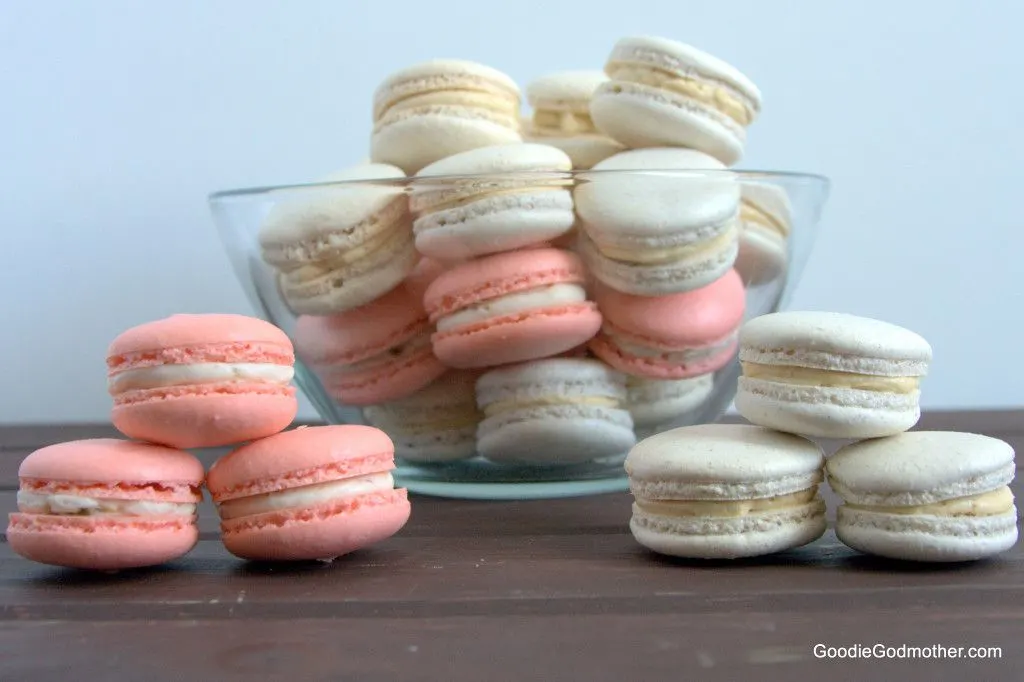
FAQs and Troubleshooting
- Are macarons difficult to make?
- No, the process is actually very straightforward! Yes, they require a lot of practice and a familiarity with your tools and ingredients to spot potential problems along the way.
- Can I use almond meal I’ve had open for a little while?
- You can, but I’ve found that almond meal that has been open for a little while dries out. If you are in a dry climate or using older almond meal, add 1/2 tsp vegetable oil to your almond meal mixture to add a bit more fat.
- Do I have to age my egg whites?
- Can I tell you a secret? No, you don’t have to. You can, and I usually try to when I’m making the French method but that’s usually only because I’m using up leftover egg whites I had on hand from something else. I usually separate my egg whites as I’m weighing out ingredients.
- Can I add flavors to my macaron shells?
- ABSOLUTELY! I love adding lemon zest to my lemon macarons (about 1/2 tsp), there’s chai tea spice in my pumpkin chai macarons, I think I actually put about a 1/2 tsp of cinnamon in the speculoos macarons here, and I add a little cocoa powder to chocolate macarons for a little subtle flavor and color, fresh vanilla beans, there are loads of options! The only thing you need to keep in mind is that when adding flavors, especially things like fresh zest and cocoa powder is that you’re playing with the ratio of fat to protein and can make the shell more delicate. I work around this by adding 1/8 tsp cream of tartar to my egg whites when I add these flavorings to help maintain a nice structure to the shell.
- What about adding color to my shells?
- To add color to your shells, use a gel coloring (I personally have this set of Americolor Soft Gel Paste Food Color, Set of 12
that I use for almost everything) or powder coloring. The reason for this is that a little bit of each adds a lot of color. If you want to achieve beautiful colors with liquid food coloring, you’d have to add too much and would throw off your ratios.
- To add color to your shells, use a gel coloring (I personally have this set of Americolor Soft Gel Paste Food Color, Set of 12
- Can I add toppings?
- Absolutely! Before baking sprinkle your shells with your favorite toppings. I’ve done sprinkles, dried rose petals, and cocoa powder. Or if you’d prefer to add your decoration after, you may paint the shells with gel color, add royal icing details, or a chocolate drizzle.
- What temperature should I set my oven?
- That depends on your oven. In the various ovens I’ve made macarons, I usually start my testing at 300 F, but I’ve gone as low as 290 F and as high as 315 F. You’ll naturally need to adjust your baking time, I’ve done everything from 10-22 minutes, so that your macarons cook through but don’t color. My best advice is to get an oven thermometer to know your oven’s true temperature, start experimenting at 300 F, and adjust accordingly. A basic thermometer like this one is only $5.
- My macarons didn’t grow feet! What happened?
- The egg whites were under beaten and there wasn’t enough air to get hot enough fast enough to create the feet in the oven. They also may have needed to dry longer
- My shells cracked!
- That’s okay, they still taste good and your family won’t mind. Usually this happens when the shells don’t rest long enough before baking or there are trapped air bubbles.
- Can I use other nut meals?
- Of course! The second most commonly used nut meal is pistachio to make delicious pistachio macarons. Experiment away! Just bear in mind that different nuts have different levels of fats so your results may not be the same without a little tweaking of your recipe.
- How many macarons will these recipes make?
- Each makes between a dozen and a dozen and a half macarons depending on size.
- What if I forget the measurements?
- I have a handy little printable for you! Click here for a PDF file you can print: Macaron Printable
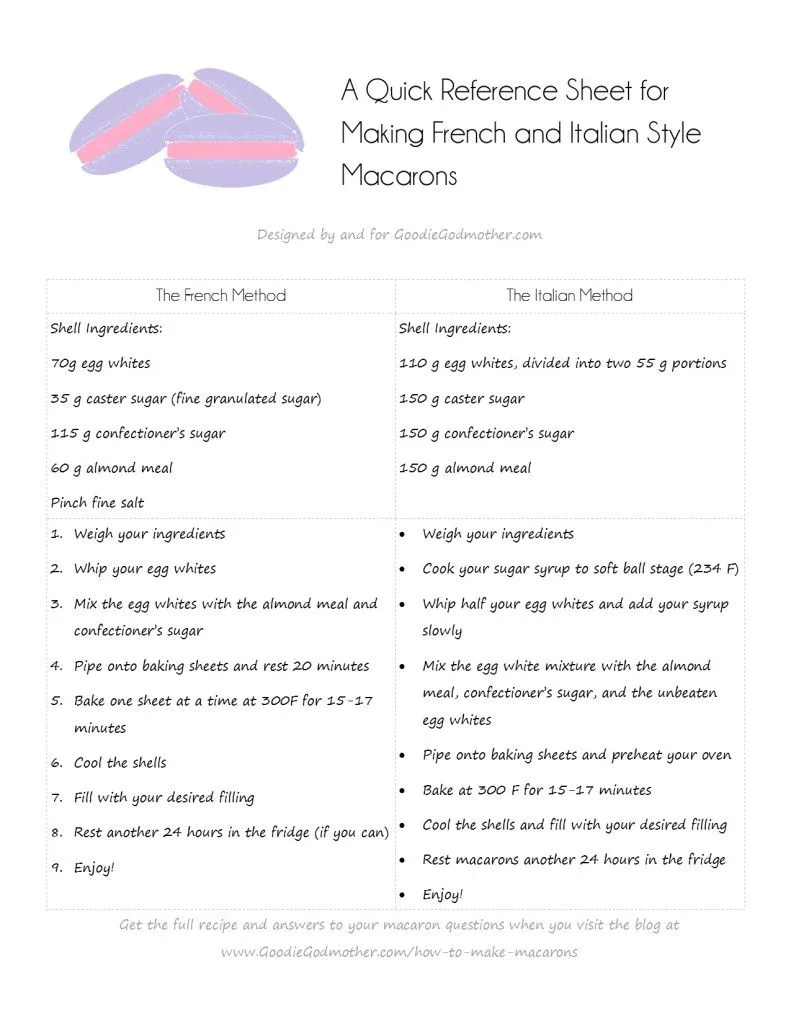
- I have a handy little printable for you! Click here for a PDF file you can print: Macaron Printable
Didn’t see your question answered? Comment below or send me an e-mail and I’ll be glad to help! Happy macaron-ing! 😉
Class dismissed!
This post contains affiliate links, which means that if you click through and make a purchase, Goodie Godmother will receive a small commission at no cost to you! Thank you for helping us maintain this blog. <3
Find this recipe and other great ideas from around the web at the Momma Told Me Link Party!

Liv
Thursday 3rd of October 2019
Why don't you mix the egg whites sugar and almond meal? I've made Italian macarons before, and that recipe said to mix them.
Mary (The Goodie Godmother)
Saturday 5th of October 2019
I've not seen a recipe that has you mix the unbeaten egg whites and almond meal in the bowl before adding to the egg white sugar syrup. That's interesting. I'd be hesitant to mix the unbeaten egg whites and almond meal/powdered sugar mixture because I'd be worried about creating clumps in the batter. After going through the work of sifting/mixing the almond meal and powdered sugar, mixing them with a clumpy substance like the unbeaten egg whites feels counter-intuitive. That being said, there are loads of recipes and variations out there, so I'm all for finding what works for you and doing that. :)
Samantha
Tuesday 15th of March 2016
Is there any way to make light and fluffy macaroons without using a nut meal..due to allergies I won't be able to try them!
The Godmother
Wednesday 16th of March 2016
Unfortunately, macarons in this style do require the use of a nut meal. :( If you'd like a coconut macaroon, I have a lovely recipe here on the blog. :)
Heather
Friday 24th of April 2015
I think I may *finally* give these a try next week some time. I'll let you know how I do. :)
TheGodmother
Saturday 25th of April 2015
Please do! :)